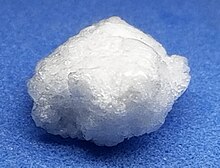Lithium bis(trifluoromethanesulfonyl)imide
Appearance
 | |
 | |
| Names | |
|---|---|
| IUPAC name
Lithium bis(trifluoromethylsulfonyl)azanide
| |
| Other names
LiTFSI
| |
| Identifiers | |
3D model (JSmol)
|
|
| ChemSpider | |
| ECHA InfoCard | 100.101.430 |
| EC Number |
|
PubChem CID
|
|
| RTECS number |
|
| UNII | |
CompTox Dashboard (EPA)
|
|
| |
| |
| Properties | |
| LiC 2F 6NO 4S 2 | |
| Molar mass | 287.09 g/mol |
| Appearance | White solid |
| Odor | odorless |
| Density | 1.33 g/cm3 |
| Melting point | 236 °C (457 °F; 509 K) |
| 80.65% (22 °C)[1] | |
| Hazards | |
| GHS labelling:[1] | |
  
| |
| Danger | |
| H301, H310, H311, H314, H372, H373, H412 | |
| P260, P262, P264, P264+P265, P270, P273, P280, P301+P316, P301+P330+P331, P302+P352, P302+P361+P354, P304+P340, P305+P354+P338, P316, P317, P319, P321, P330, P361+P364, P363, P405, P501 | |
| Safety data sheet (SDS) | [2] |
| Related compounds | |
Other anions
|
Bistriflimide |
Except where otherwise noted, data are given for materials in their standard state (at 25 °C [77 °F], 100 kPa).
| |
Lithium bis(trifluoromethanesulfonyl)imide, often simply referred to as LiTFSI, is a hydrophilic salt with the chemical formula LiC2F6NO4S2.[2] It is commonly used as Li-ion source in electrolytes for Li-ion batteries as a safer alternative to commonly used lithium hexafluorophosphate.[3] It is made up of one Li cation and a bistriflimide anion.
Because of its very high solubility in water (> 21 m), LiTFSI has been used as lithium salt in water-in-salt electrolytes for aqueous lithium-ion batteries.[4][5]
References
[edit]- ^ Gilbert, William J. R.; Safarov, Javid; Minnick, David L.; Rocha, M. Alejandra; Hassel, Egon P.; Shiflett, Mark B. (2017-06-05). "Density, Viscosity, and Vapor Pressure Measurements of Water + Lithium Bis(trifluoromethylsulfonyl)imide Solutions". Journal of Chemical & Engineering Data. 62 (7). American Chemical Society (ACS): 2056–2066. doi:10.1021/acs.jced.7b00135. ISSN 0021-9568.
- ^ Pubchem. "90076-65-6 | C2F6LiNO4S2 - PubChem". pubchem.ncbi.nlm.nih.gov. Retrieved 2017-03-11.
- ^ Kalhoff, Julian; Bresser, Dominic; Bolloli, Marco; Alloin, Fannie; Sanchez, Jean-Yves; Passerini, Stefano (2014-10-01). "Enabling LiTFSI-based Electrolytes for Safer Lithium-Ion Batteries by Using Linear Fluorinated Carbonates as (Co)Solvent". ChemSusChem. 7 (10): 2939–2946. Bibcode:2014ChSCh...7.2939K. doi:10.1002/cssc.201402502. ISSN 1864-564X. PMID 25138922.
- ^ Suo, Liumin; Borodin, Oleg; Gao, Tao; Olguin, Marco; Ho, Janet; Fan, Xiulin; Luo, Chao; Wang, Chunsheng; Xu, Kang (2015-11-20). ""Water-in-salt" electrolyte enables high-voltage aqueous lithium-ion chemistries". Science. 350 (6263): 938–943. doi:10.1126/science.aab1595. ISSN 0036-8075. PMID 26586759. S2CID 206637574.
- ^ Smith, Leland; Dunn, Bruce (2015-11-20). "Opening the window for aqueous electrolytes". Science. 350 (2015): 918. doi:10.1126/science.aad5575. ISSN 0036-8075. PMID 26586752. S2CID 206643843.
